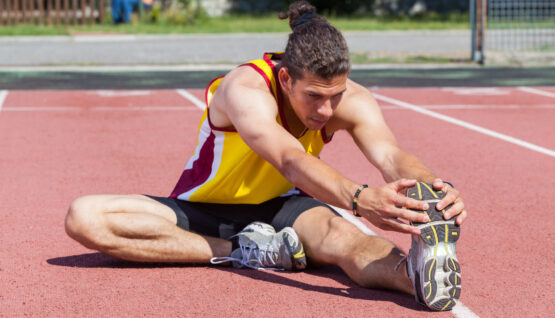28 June 2019
28 June 2019
Do you want to practice sports effectively and prevent injuries? Never skip warm-up, and after finishing the workout, make sure to cool down and regenerate your body.
While professional athletes cannot imagine training without warming up, many amateurs underestimate its importance. And in reality, it is an essential part of the training.
Warm-up prepares the whole body for physical exertion. At rest, our muscles use just 15 percent of heart rate, and during exercise - over 70 percent. As a result of the warm-up, not only the muscles are safely activated, but also the cardiovascular system, respiratory system and internal organs. It will be easier for us to implement the training assumptions and improve our well-being. Warm-up is one of the most important factors that will minimize the risk of injuries connected with overload, typical for runners, but also minor or severe injuries, such as muscle tears or tendon stretches – says dr. Mateusz Janik, orthopedist at the Carolina Medical Center.
Although almost 70 percent of runners declare that they warm up before training, they often do it inaccurately, too briefly and without a plan. According to a survey conducted by Runner's World (data from 2016), 41 percent of runners warm up before training by doing stretching exercises. Unfortunately, stretching alone is definitely not enough!
The warm-up should be adjusted to the specific activity. We warm up in a different way before the marathon, and in a different way before the crossfit. The marathon is a long-term effort, but of moderate intensity. During marathon there is no excessive lactic acid production (called acidification of the body). The closer to the end of the run, the acidification will increase. The marathoner enters a higher turnover more gently and in the long run. Therefore, the warm-up should be milder than before crossfit, which is considered to be intense. During the crossfit, the effort will be shorter, but the body will immediately enter a higher pace, the so-called high turnover – says Mateusz Jenda, physiotherapist and motor therapy trainer from Carolina Medical Center.
An appropriate warm-up consists of several stages that together form an integrated whole. Regardless of the type of training you plan, do not skip any of the elements. And these are: preparation for the effort, activation and dynamic stretching. Various exercises will be adapted to the specific activity. Remember also that the warm-up should not be more intense than training. It cannot cause excessive fatigue. Duration: 10-20 minutes.
Stage 1 – preparation for the effort
Objective: increase in body temperature and heart rate acceleration. Begin with general exercises: first, gently jog, and then add swinging of your arms. First, do symmetrical exercises (e.g. circular waving), then go to asymmetrical exercises (e.g. alternate circuits, skip in various forms, additional step, forward-backward movement, moving sideways).
Stage 2 – activation
Objective: stimulation of muscle groups that will be active during training. Focus on the gluteal muscles as well as on the muscles stabilizing the body (so-called CORE). Thanks to this action, during a long hours of marathon you will be able to better control your running figure and technique. Examples of exercises: lifting the hips while lying on the back, board, board sideways.

Stage 3 – dynamic stretching
Objective: to prepare the muscles for training. During exercise, they will shrink and unclench, that is, increase tension and relax. Dynamic stretching should consist of such exercises. Sample exercise: keep the quadriceps stretched for 2-3 seconds, then dynamically tighten it. To do this, pull the heel to the buttock and then make a dynamic kick with a controlled knee extension.
If you practice jogging, weightlifting or popular interval training (consisting of interleaving the high and low heart rate), it is also worth to activate (stimulate) the nervous system during the warm-up. To do this, do some dynamic exercises to enter the high heart rate. You will awaken the body to work and get used to the intense effort. Perform the moves that will dominate in your workout. Sample sprinting exercises: low skipping with dynamic hand workout (5-7 seconds), and then a dynamic start on the 5-10 meter section.
Before the marathon, if you are not a professional, the nervous system stimulation phase is not necessary. During the course of the effort, our body will start to go higher over time, but not as violently as in the case of intensive training – explains the physiotherapist.
Do you know that what you do immediately after the workout will affect how you will feel the next day? After training, the muscles are well supplied and tightened. That's why they should be cooled down. Unfortunately, many people ignore a very important part of your post-workout exercises. Its main goal is to accelerate all regenerative processes.
After finishing the workout, in order to cool down the body, it is worth marching a few dozen meters (for a few minutes) or running so that all the metabolic products that exuded during the effort are removed as soon as possible along with blood, and neutralized. After lowering the body temperature, we start stretching exercises – says physiotherapist Mateusz Jenda.
During the warm-up you perform dynamic stretching, and after exercising, you perform static stretching. The purpose of post-exercise stretching is to relax muscles and normalize muscle tone. There is no room for dynamic arm and leg movements, and the time to do exercises is an individual matter. Combine stretching with slow breathing. Relax, take a certain position and try to stay in this position for about 30 seconds (depending on pain and tension tolerance). Attention! Stretching after exercise should not be painful. Focus on the muscles bending the hip, i.e. quadriceps, hip and lumbar muscles, as well as on the buttocks, ischium and shinbone group and calves.
Ending the training without cooling and static stretching results in longer time needed for regeneration necessary to start the next training. It can cause overtraining and even injury. Lack of stretching after exercise causes that our muscles are contorted.
By cooling and stretching the muscles, we optimize tissue regeneration processes. Maintaining the proper blood supply of tissues improves their nutrition, oxygenation and cleansing of metabolic products. If we want to train better, remember about good regeneration, which starts right after the exercise – says Dr. Mateusz Janik.
